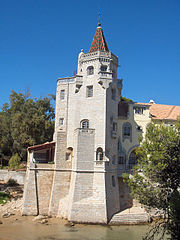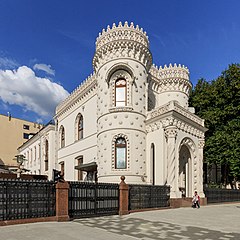Neo-Manueline



네오-마누엘린 양식은 포르투갈의 16세기 마누엘린 후기 고딕 건축 양식으로부터 영향을 받은 건축의 리바이벌 양식이다. 네오-마누엘린 양식 건축물은 포르투갈, 브라질, 그리고 포르투갈어를 사용하는 세계(구 포르투갈 제국) 전역에 지어졌다.
Neo-Manueline is a revival style of architecture which drew from the 16th century Manueline Late Gothic architecture of Portugal. Neo-Manueline constructions have been built across Portugal, Brazil, and the Lusophone world (the former Portuguese Empire).
역사
History
‘마누엘리노’라는 용어는 1842년 브라질 미술사가인 프란시스코 아돌포 드 바르하겐(1816-1878)이 포르투갈의 마누엘 1세 통치 기간(1495~1521) 동안 발전한 생동감 넘치는 예술 양식을 지칭하기 위해 도입했다. 마누엘린 양식은 대항해 시대와 포르투갈 제해권의 전성기와 맞물려 발전했다. 18세기 중반 이래 유럽 전역에 퍼진 고딕 리바이벌 양식 건축 유행의 흐름속서, 마누엘린 양식은 가장 정통적인 포르투갈 건축 양식으로 간주되었다.
The term manuelino was introduced in 1842 by Brazilian art historian Francisco Adolfo de Varnhagen to designate the exuberant artistic style that developed during the reign of Manuel I of Portugal (1495–1521). The Manueline style coincided with the Age of Discovery and the peak of Portuguese maritime power. In the sequence of the Gothic Revival architecture fashion that spread for all over Europe since the middle of the 18th century, the Manueline style was considered the most authentic Portuguese architectural style.
네오-마누엘린 양식은 1839년에서 1849년 사이에 페르디난트 2세가 (포르투갈) 신트라에 페나 궁전을 건설하면서 시작되었다. 또 다른 선구적인 프로젝트는 1860년대 리스본에 있는 제로니무스 수도원의 복원 작업이었는데, 이 과정에서 마누엘린 양식의 수도원은 네오-마누엘린 양식으로 지어진 새로운 탑과 별관(현재 해양 박물관과 국립 고고학 박물관으로 사용)을 추가로 갖추게 되었다. 이 기간 동안 상징적인 벨렝 타워도 여러 네오-마누엘린 양식의 요소를 추가하며 복원되었다. 포르투갈에 있는 다른 중요한 네오-마누엘린 양식 건물로는 리스본의 호시우 기차역(1886~90), 팰리스 호텔 두 부사코(1888~1907), 신트라 타운 홀(1906~09), 카스카이스의 카스트루 기마랑이스 백작 궁전(1900), 신트라에 있는 킨타 다 헤갈레이라(1904~10) 등이 있다. 네오-마누엘린 양식은 개인 주택 같은 더 작은 건물에도 사용되었다.
Neo-Manueline started with the construction of the Pena Palace in Sintra by Ferdinand II between 1839 and 1849. Another pioneering project was the restoration of the Jerónimos Monastery in Lisbon during the 1860s, in which the Manueline monastery gained a new tower and annexes built in Neo-Manueline style (which now house the Maritime Museum and the National Archaeology Museum). During this time the iconic Belém Tower was also restored with several Neo-Manueline additions. Other important Neo-Manueline buildings in Portugal are Rossio Railway Station, Lisbon (1886–90), Palace Hotel of Bussaco (1888–1907), the Sintra Town Hall (1906–09), the Counts of Castro Guimarães Palace in Cascais (1900) and the Quinta da Regaleira in Sintra (1904–10). The Neo-Manueline was also used in smaller buildings like private houses.
네오-마누엘린 양식은 결국 식민지와 옛 포르투갈 식민지로 확산되었다. 브라질에서는 주로 포르투갈 협회에서 지은 여러 네오-마누엘린 양식 건물이 있다. 그중 가장 중요한 건축물은 1880년에서 1887년 사이에 포르투갈 이민자들이 리우데자네이루 중심부에 세운 왕립 포르투갈 도서관(헤아우 가비네치 포르투게스 지 레이투라)이다. 브라질의 다른 마누엘린 양식 건물에는 산투스의 포르투갈 센터(센트루 포르투게스 지 산투스; 1898~1901), 바이아의 포르투갈 도서관(1915~18), 리우데자네이루의 포르투갈 문학 고등학교(리세우 리테라리우 포르투게스; 1938)가 있다.
Neo-Manueline eventually spread to the colonies and former Portuguese colonies. In Brazil, there are several Neo-Manueline buildings, usually built by Portuguese associations. The most important of these is the Real Gabinete Português de Leitura (Royal Portuguese Library), built between 1880 and 1887 by Portuguese immigrants in the centre of Rio de Janeiro. Other Manueline buildings in Brazil include the Portuguese Center in Santos (Centro Português de Santos, 1898–1901), the Portuguese Library of Bahia (1915–18) and the Portuguese Literary Liceum (Liceu Literário Português) in Rio de Janeiro (1938).
네오-마누엘린 양식 건물의 예들은 이전 포르투갈 식민지 제국의 아프리카 및 아시아 지역에서도 찾아볼 수 있다.
Examples of Neo-Manueline buildings can also be found in African and Asian territories of the former Portuguese Colonial Empire.
포르투갈 문화와 직접적인 관련이 없는 국가들에서도 네오-마누엘린 양식의 영향을 받은 건물들의 예가 있다. 좋은 예가 러시아 모스크바에 있는 아르세니 모로조프 저택(1895~99)이다.
There are also examples of buildings influenced by the Neo-Manueline style in countries that were not directly related with the Portuguese culture. A fine example is the Arseny Morozov House (1895–99) in Moscow, Russia.
갤러리
Gallery






- 출처 : 「Neo-Manueline」, Wikipedia(en), 2022.10.25.